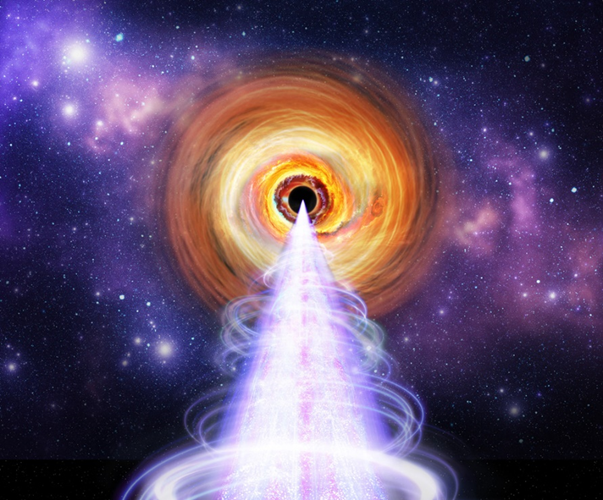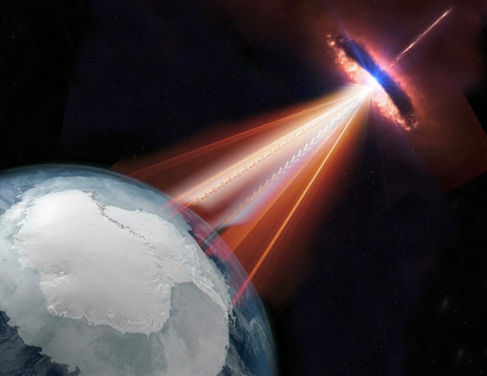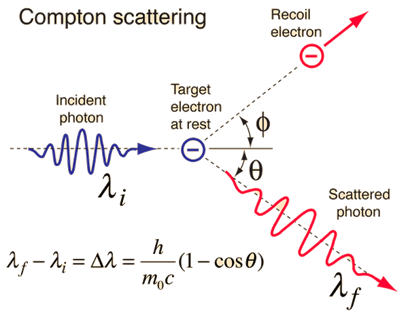All Science News

NASA's IXPE Solves Mystery of X-Ray Creation in Black Holes
The famous space mission IXPE was launched in December 2021 and is a collaboration between NASA and the Italian Space Agency, with scientific partners in 12 countries. It was built to reveal the secrets of the most extreme objects in the universe, such as the remnants of supernova explosions, or the jets of particles that erupt from black holes (blazars) by opening a new window to the Universe.
New findings by an international team of astrophysicists, based on data collected by IXPE, have revealed the mechanism that creates the bright X-ray radiation, which is associated with the extremely powerful plasma jets that erupt from supermassive black holes.

Artist's impression of BL Lacertae's jet showing the ordered magnetic field that creates
the very high polarization in the optical.
The lack of similar degree of polarization in X-rays, as found by the IXPE observations,
is a clear smoking gun for Compton scattering.NASA/Pablo Garcia
The most massive black holes reside in distant galaxies, feeding abundant gas into their galactic centers. A small percentage of them create persistently bright objects in the sky, consisting of a disk of gas and two aligned, fast, and extremely powerful jets of plasma that emerge vertically from the black hole. When the jets are oriented towards Earth, we call these systems blazars.

Artist's impression of a blazar. Source: ICECUBE/NASA
While the first blazars were discovered in the 1960s, how the particles inside the jets are accelerated and how the high-energy X-rays are produced have remained a mystery to this day. The X-rays could be emitted by either accelerated electrons or protons, reaching extremely high energies.
In a recent study published in the Astrophysical Journal Letters, astronomers using IXPE found that the X-rays in the jets must be created through Compton scattering, a mechanism that originates from the electrons inside the jet.
Compton scattering (or the Compton effect) is the quantum theory of photons scattering (changing direction of motion) after an interaction with a charged particle, usually an electron. When the photon hits an electron, it can gain energy after scattering.

Source: http://hyperphysics.phy-astr.gsu.edu/hbase/quantum/compton.html
In the case of a blazar jet, the electrons have enough energy to scatter lower-energy photons to X-ray energies. IXPE is the only satellite in the world that can measure the polarization of X-rays. Polarization is a property of light that describes the average direction of the electromagnetic waves that make up the light. If the X-rays have a low degree of polarization compared to the polarization in the optical, then they are produced by Compton scattering by electrons. If the X-rays and the optical have the same degree of polarization, then the radiation is produced by protons.
The latest study from IXPE used data from a blazar called BL Lacertae along with several optical and radio telescopes located around the Earth, including the RoboPol polarimeter at the Skinakas Observatory. RoboPol has been involved in many of IXPE's black hole discoveries. This time, however, the Skinakas observations were of particular importance because of the variability in BL Lacertae's optical polarization. During the X-ray polarization observations, BL Lac's optical polarization reached 47%, while in X-rays it was lower than 7.4%.
"This is the most polarized blazar ever observed! The Skinakas Observatory contributed significantly to the detection of the high degree of polarization. Without the observations from Skinakas and the other telescopes, we would not have been able to see such a high degree of polarization," said Ioannis Liodakis, one of the lead authors of this study and a researcher at the Institute of Astrophysics – FORTH.

Dr. Ioannis Liodakis, Researcher, Institute of Astrophysics, FORTH
I. Liodakis is responsible for coordinating IXPE's optical and radio observations of blazars since its launch in 2021. IXPE's results clearly show the X-ray-producing electrons in the jets from blazars.
In this study, researchers Dmitry Blinov and Carolina Casadio from the Institute of Astrophysics of FORTH were also involved.
IXPE is managed by NASA's Marshall Space Flight Center in Huntsville, Alabama. Ball Aerospace, based in Broomfield, Colorado, manages spacecraft operations in conjunction with the University of Colorado Boulder's Laboratory for Atmospheric and Space Physics.
Learn more about the ongoing IXPE mission here: https://www.nasa.gov/ixpe
Publication Link: https://arxiv.org/pdf/2505.01832
NASA’s press release: https://www.nasa.gov/centers-and-facilities/marshall/nasas-ixpe-reveals-x-ray-generating-particles-in-black-hole-jets/








